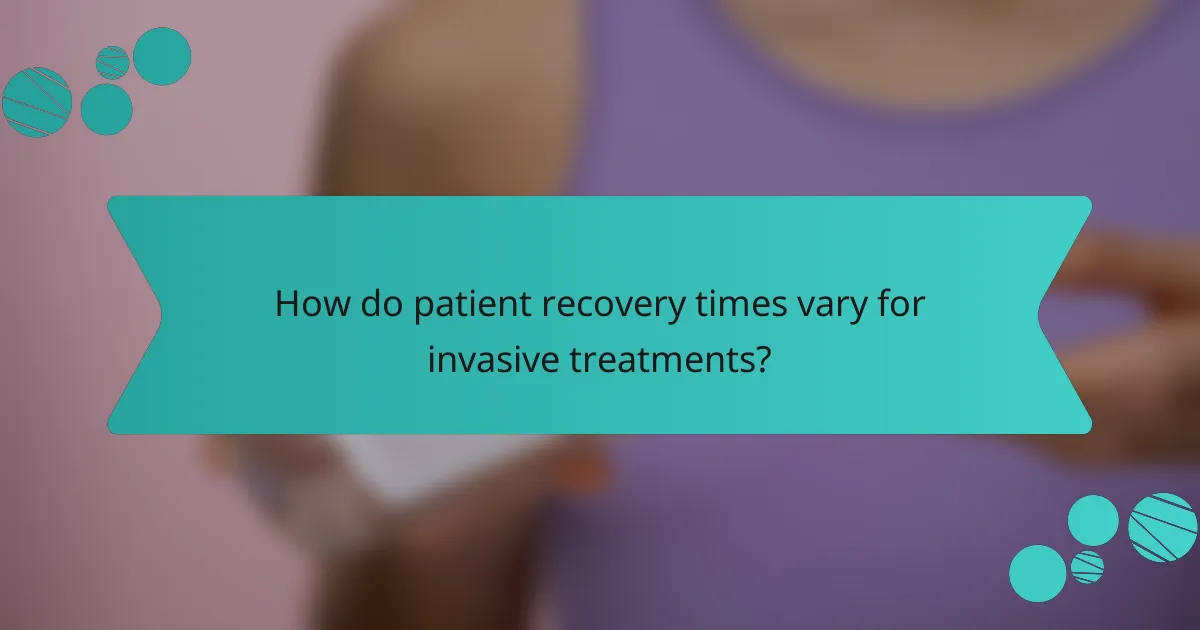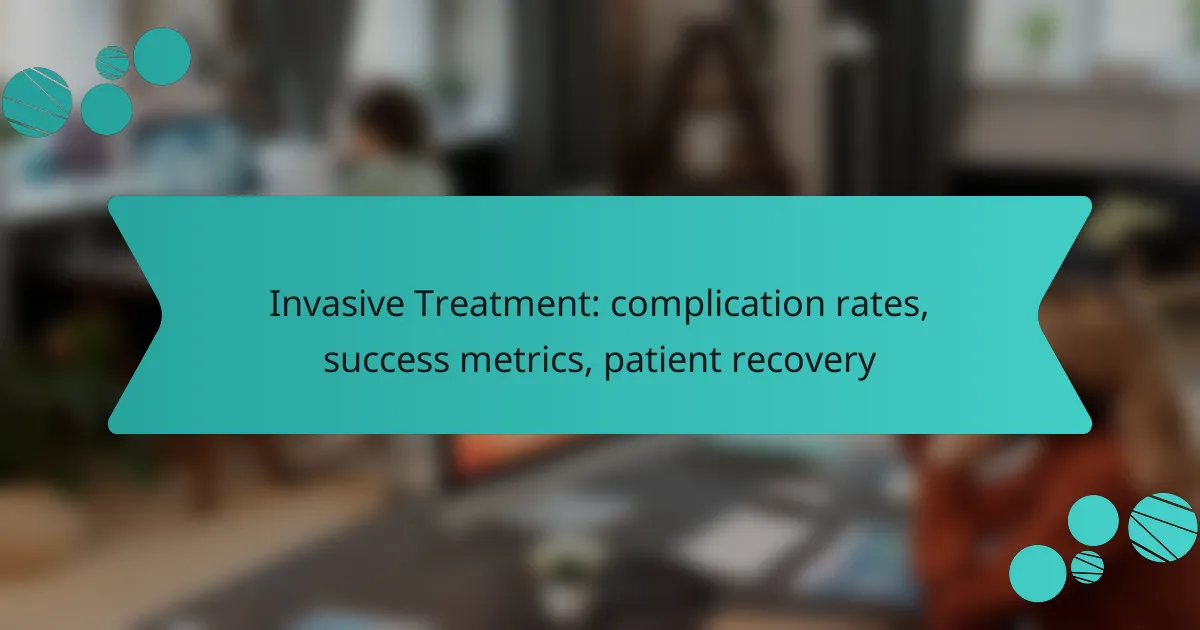Invasive treatments can offer significant benefits, but they also come with varying complication rates influenced by the procedure type and patient health. Success metrics, including successful outcome rates and recovery times, are essential for assessing the effectiveness of these interventions. Patient recovery can differ widely, often ranging from a few days to several weeks, depending on individual circumstances and the complexity of the treatment.

What are the complication rates of invasive treatments in Canada?
Invasive treatments in Canada generally have complication rates that vary depending on the type of procedure, patient demographics, and underlying health conditions. While many procedures are performed successfully, complications can occur in a notable percentage of cases, necessitating careful consideration before proceeding.
Average complication rate
The average complication rate for invasive treatments in Canada typically ranges from 5% to 15%, depending on the specific procedure. For example, surgical interventions like laparoscopic surgeries may have lower rates, while more complex procedures, such as open-heart surgery, can see rates exceeding 10%. Understanding these averages helps patients weigh the risks associated with their treatment options.
Factors influencing complication rates
Several factors can influence the complication rates of invasive treatments, including the patient’s age, overall health, and the presence of comorbidities. Additionally, the skill and experience of the medical team, as well as the facility’s standards and protocols, play crucial roles in determining outcomes. Patients should discuss these factors with their healthcare providers to gain a clearer understanding of their specific risks.
Comparison with non-invasive treatments
Non-invasive treatments generally have lower complication rates compared to invasive procedures, often falling below 5%. For instance, therapies such as physical rehabilitation or medication management typically pose fewer risks. However, the effectiveness of non-invasive treatments may vary, and in some cases, they may not provide the same level of benefit as invasive options, making it essential for patients to consider both approaches in their treatment plans.

What are the success metrics for invasive treatments?
Success metrics for invasive treatments typically include the rates of successful outcomes, complication rates, and patient recovery times. These metrics help evaluate the effectiveness and safety of various procedures, guiding both patients and healthcare providers in decision-making.
Success rate statistics
Success rates for invasive treatments can vary widely depending on the procedure and patient demographics. Generally, success rates can range from around 70% to over 90% for many common surgeries. For example, laparoscopic cholecystectomy often boasts success rates exceeding 90%, while more complex procedures may have lower rates.
It’s essential to consider the context of these statistics, as they may be influenced by factors such as the surgeon’s experience, the facility’s quality, and the patient’s overall health. Always consult specific studies or institutional data for the most relevant statistics.
Common success metrics used
Commonly used success metrics for invasive treatments include overall survival rates, complication rates, and functional outcomes. Overall survival rates indicate the percentage of patients who remain alive after a specified period post-treatment, often measured at one, three, or five years.
Complication rates reflect the frequency of adverse events following a procedure, which can range from minor issues to severe complications. Functional outcomes assess how well patients recover their pre-treatment abilities, often measured through surveys or clinical assessments.
Variability by treatment type
The success metrics for invasive treatments can differ significantly based on the type of procedure performed. For instance, orthopedic surgeries like hip replacements may emphasize functional recovery and pain relief, while cardiac surgeries might focus more on survival rates and complication rates.
Additionally, minimally invasive techniques often report higher success rates and lower complication rates compared to traditional open surgeries. Patients should discuss the specific metrics relevant to their treatment options with their healthcare provider to understand the expected outcomes fully.

How do patient recovery times vary for invasive treatments?
Patient recovery times for invasive treatments can vary significantly based on the type of procedure, individual health factors, and post-treatment care. Generally, recovery can range from a few days to several weeks, depending on the complexity of the treatment and the patient’s overall condition.
Average recovery time by procedure
Recovery times differ widely among various invasive procedures. For instance, laparoscopic surgeries typically require about one to two weeks for initial recovery, while open surgeries may take three to six weeks. More complex procedures, such as organ transplants, can necessitate a recovery period of several months.
In contrast, minimally invasive techniques like endoscopies often allow patients to return to normal activities within a few days. Understanding these averages helps set realistic expectations for patients undergoing treatment.
Factors affecting recovery duration
Several factors influence how long recovery takes after invasive treatments. Patient age, overall health, and pre-existing medical conditions can significantly impact healing times. For example, younger patients or those in good health often recover faster than older patients or those with chronic illnesses.
The type of anesthesia used and the extent of the procedure also play crucial roles. Procedures requiring general anesthesia may involve longer recovery times compared to those performed under local anesthesia.
Post-treatment care recommendations
Effective post-treatment care is essential for a smooth recovery. Patients should follow their healthcare provider’s instructions regarding activity levels, wound care, and medication management. It’s advisable to keep the surgical site clean and dry to prevent infections.
Additionally, maintaining a balanced diet and staying hydrated can support healing. Patients should also schedule follow-up appointments to monitor their recovery progress and address any concerns promptly.

What are the prerequisites for undergoing invasive treatments?
Prerequisites for invasive treatments include meeting specific eligibility criteria, undergoing thorough pre-treatment assessments, and consulting with specialists. These steps ensure that patients are suitable candidates and can minimize risks associated with the procedures.
Patient eligibility criteria
Patient eligibility criteria vary based on the type of invasive treatment but generally include age, overall health, and specific medical conditions. For instance, patients with chronic illnesses or those on certain medications may face restrictions. It’s essential to evaluate these factors to determine if a patient can safely undergo the procedure.
Additionally, lifestyle factors such as smoking or obesity can impact eligibility. Healthcare providers often use standardized guidelines to assess these criteria, ensuring that only suitable candidates proceed with treatment.
Pre-treatment assessments
Pre-treatment assessments are critical for identifying any potential risks before an invasive procedure. These assessments typically involve a comprehensive medical history review, physical examinations, and diagnostic tests such as blood work or imaging studies. The goal is to uncover any underlying issues that could complicate the treatment.
Patients may also undergo functional assessments to evaluate how well their organs are performing. For example, cardiac evaluations are common for patients undergoing surgeries that may affect heart function. This thorough evaluation process helps in tailoring the treatment plan to the individual’s needs.
Consultation with specialists
Consultation with specialists is a vital step in the preparation for invasive treatments. Specialists, such as surgeons or anesthesiologists, provide insights into the procedure, potential complications, and recovery expectations. This dialogue helps patients make informed decisions about their treatment options.
During these consultations, patients should discuss their medical history, ask questions about the procedure, and express any concerns. This open communication fosters a collaborative approach to care, ensuring that all aspects of the patient’s health are considered before proceeding.

What are the emerging trends in invasive treatment outcomes?
Emerging trends in invasive treatment outcomes indicate improvements in complication rates, success metrics, and patient recovery times. Innovations in techniques and technology are reshaping how procedures are performed and how patients heal.
Innovations in surgical techniques
Recent advancements in surgical techniques, such as minimally invasive procedures, have significantly reduced recovery times and complication rates. Techniques like laparoscopic surgery allow for smaller incisions, leading to less trauma and quicker healing.
Surgeons are increasingly adopting robotic-assisted surgeries, which enhance precision and control during operations. This trend has shown promising results in various fields, including urology and gynecology, improving success rates and patient satisfaction.
Impact of technology on recovery
Technology plays a crucial role in enhancing patient recovery post-surgery. Tools such as telemedicine enable healthcare providers to monitor patients remotely, ensuring timely interventions and reducing the need for in-person visits.
Wearable devices that track vital signs and recovery metrics are becoming more common. These devices help patients and doctors stay informed about recovery progress, allowing for personalized adjustments to care plans.
Future directions in patient care
The future of patient care in invasive treatments is likely to focus on personalized medicine and data-driven approaches. Tailoring treatments based on individual patient profiles can improve outcomes and minimize risks.
Additionally, ongoing research into regenerative medicine and tissue engineering holds the potential to enhance recovery further. These innovations could lead to better healing processes and lower complication rates in the coming years.
